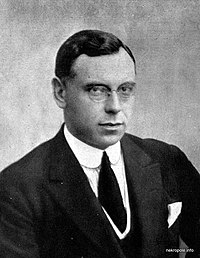Zigfrīds Anna Meierovics
Zigfrīds Anna Meierovics | |
|---|---|
 | |
| 2nd Prime Minister of Latvia | |
| In office 19 June 1921 – 26 January 1923 | |
| President | Jānis Čakste |
| Preceded by | Kārlis Ulmanis |
| Succeeded by | Jānis Pauļuks |
| In office 28 June 1923 – 26 January 1924 | |
| President | Jānis Čakste |
| Preceded by | Jānis Pauļuks |
| Succeeded by | Voldemārs Zāmuēls |
| Foreign Minister of Latvia | |
| In office 18 November 1918 – 26 January 1924 | |
| Prime Minister | Kārlis Ulmanis Jānis Pauļuks Himself |
| Preceded by | Position established |
| Succeeded by | Ludvigs Sēja |
| In office 18 December 1924 – 22 August 1925 | |
| Prime Minister | Hugo Celmiņš |
| Preceded by | Ludvigs Sēja |
| Succeeded by | Hugo Celmiņš |
| Personal details | |
| Born | 5 February 1887 (part of the Russian Empire) |
| Died | 22 August 1925 (aged 38) |
| Resting place | Riga Forest cemetery |
| Political party | Latvian Farmers' Union |
| Spouse | Anna Meierovics (née Fielhold) |
| Children | Helmuts, Ruta, Gunars |
| Profession | Diplomat, Politician |
Zigfrīds Anna Meierovics (5 February [O.S. 24 January] 1887, Durbe[1] – 22 August 1925, near Tukums) was a Latvian politician and diplomat who served as the first Foreign Minister of Latvia from its independence until 1924 and again from December of the same year until his death. He also served two terms as the Prime Minister of Latvia from June, 1921 to January, 1923 and from June 1923 to January, 1924. He was one of the founders of the Latvian Farmers' Union, one of Latvia's oldest political parties.[1][2]
Early life
[edit]Meierovics was born into the family of a Jewish doctor and his Latvian wife Anna, who died in childbirth. His father became mentally ill and therefore young Meierovics grew up with his uncle's family in Sabile. He studied at the Riga Polytechnicum.
Career
[edit]After 1911 Meierovics belonged to various Latvian organizations, notably the Riga Latvian Society. During World War I he worked in the Latvian Refugee Committee and the organizing committee of the Latvian Riflemen units. After the February Revolution he moved to Riga to work as a professional politician. In September 1917, he attended the Congress of the Peoples of Russia.
On 23 October, and again on 11 November 1918, as the representative of Latvian Provisional National Council, he received written confirmation that the United Kingdom acknowledged the de facto statehood of Latvia and National Council as its government. Meierovics became the first Minister of Foreign Affairs of Latvia on 19 November 1918, a day after the Republic of Latvia was proclaimed. He was a member of the Latvian Peoples Council, the Constitutional Assembly of Latvia and the 1st Saeima.
Honours and awards
[edit]On 17 March 1922, Meierovics was awarded the Grand Cross of the Polish Order of Polonia Restituta. On 30 May 1922, he received the Grand Cross of the Order of St. Sylvester, 1st Class (Holy See).[2] He was also awarded the Order of the Three Stars, First Class (Latvia), Order of the White Rose (Finland) and Croix de Guerre (France)[1]
Other awards included the Order of Lāčplēsis, 3rd class (Latvia) and the Austro-Hungarian Order of the Red Cross.
Private life
[edit]On 28 September 1910 Meierovics married Anna Fielhold, with whom he had three children, two boys and a girl; Helmuts (1914–1998), Ruta (1916-1999, surname Kose in marriage) and Gunars (1920–2007). On 18 February 1924 they officially divorced, and on 7 June of the same year he married Kristīne Bakmane.[2]
His son Gunars was a candidate for President of Latvia in 1993. It was the first presidential election after the end of the Soviet occupation. The 5th Saeima failed to elect Meierovics, instead choosing Guntis Ulmanis, the great-nephew of Kārlis Ulmanis.
Death
[edit]Zigfrīds Anna Meierovics died in a car accident on 22 August 1925 at the age of 38. The car with the minister, his chauffeur, his ex-wife and his children from the first marriage, departed from Tukums where his first wife's mansion was located, heading for the seaside. About 18 km from Tukums the car accidentally drove off the road and overturned. While other passengers suffered only minor bruises, the minister was apparently crushed by the vehicle, resulting in a broken neck and severed spinal cord. The chauffeur had to run about 2 km to the nearest living place, but before the doctor arrived, the minister died on the scene.[3] His widow shot herself on 2 December 1925 and is buried next to him.
References
[edit]- ^ a b c Pētersone, Inta (1999). Latvijas Brīvības cīņas 1918–1920 : enciklopēdija (in Latvian). Riga: Preses nams. ISBN 9984-00-395-7. OCLC 43426410.
- ^ a b c Treijs, Rihards (2004). Prezidenti : Latvijas valsts un ministru prezidenti (1918–1940) (in Latvian). Riga: Latvijas Vēstnesis. ISBN 9984-731-47-2. OCLC 61227165.
- ^ "Подробности катастрофы," newspaper Сегодня, Sunday, 08–23–25, p. 2. Retrieved 05–05–11.
External links
[edit]- 1887 births
- 1925 deaths
- People from South Kurzeme Municipality
- People from Courland Governorate
- Jewish Latvian politicians
- Latvian Farmers' Union politicians
- Prime ministers of Latvia
- Ministers of foreign affairs of Latvia
- Deputies of the Constitutional Assembly of Latvia
- Deputies of the 1st Saeima
- Latvian people of Jewish descent
- Riga Technical University alumni
- Recipients of the Order of Lāčplēsis, 3rd class
- Grand Crosses of the Order of Polonia Restituta
- Recipients of the Croix de Guerre (France)
- Knights of the Order of St. Sylvester
